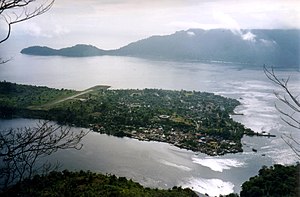Banda Besar
| Banda Besar | |
|---|---|
| View from Banda Api to Banda Neira and to Banda Besar in the background. | |
| Waters | Banda Lake |
| Archipelago | Banda Islands |
| Geographical location | 4 ° 33 ' S , 129 ° 55' E |
| length | 12 km |
| width | 3 km |
| surface | 26.37 km² |
| Highest elevation | 536 m |
| main place | Lonthoir |
Banda Besar (formerly also called Groß-Banda , Lontar , Lonthor or Lonthoir ) is one of the Indonesian Banda Islands , which in turn belong to the Moluccas , and is located in the Banda Sea .
Banda Besar is one of the three middle Banda Islands: Banda Neira is 800 meters away in the north and the volcanic island of Banda Api is 1 km away . 1 kilometer north is the small island of Pualu Kraka, around 200 meters long. Banda Besar and Pula Kraka are located on the southern and eastern edge of a caldera with a diameter of around seven kilometers, inside of which are the islands of Banda Neira and Banda Api .
At 12 kilometers long and 3 kilometers wide, Banda Besar is the largest of the Banda Islands. Other names for the island are Lontar or Lonthoir. The largest settlements are Lonthoir, Selamon and Waer. There are two dilapidated forts: at Lonthoir Benteng Hollandia , at Waer Benteng Concordia . The entire island is criss-crossed by a chain of hills and small mountains with a maximum height of 536 meters.
Nutmeg is grown on the island ; the trade in it brought the inhabitants great wealth. Until the early 17th century, the Banda Islands were ruled by locals, the Orang Kaya (which means: "rich men"). The Portuguese were the first Europeans to dominate the spice trade from the 16th century. They were replaced by the Dutch from 1609.
In 1621 the newly appointed Governor General of the Vereenigde Oostindische Compagnie , Jan Pieterszoon Coen , conquered the islands and thereby also ended the rule of the Orang Kaya . The population was killed or enslaved; many Bandanese fled to other islands. Slaves from different countries were brought to Banda Besar to work on the nutmeg plantations.
Web links
Individual evidence
- ^ Christopher G. Newhall, Daniel Dzurisin: Historical unrest at large calderas of the world . USGS Bulletin 1855, 1988 (English, PDF, 37.0 MB), pp. 339-344.
- ^ National Geospatial-Intelligence Agency (ed.): Sailing directions (enroute): New Guinea. Pub. 164, 12th edition, 2011, p. 60 (English, PDF, 3.9 MB).
- ^ Vincent C. Loth: Pioneers and Perkeniers: The Banda Islands in the 17th Century.

